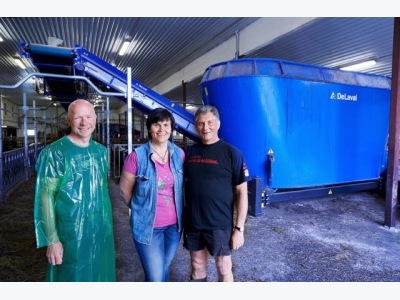Norwegian dairy farmer profits from automatic feeding

Feeding is often the biggest expense on any dairy farm. The labour costs related to and the feed itself amount to up to 70% of any farm’s production costs. Making feeding methods more efficient does not just save costs, it increases milk yields.
DeLaval has therefore developed an automated feeding solution that takes the time and guesswork out of feeding and at the same time ensures that all cows in the herd get the right feed. This will result in less stressed cows, fed the right amount and producing more milk as a result. "We have farms with 60 cows and others with 600 cows using our automatic feeding system, says Beata Kruba-Wroblewska, Feeding Systems Assortment Manager at DeLaval "and they all see benefits in feeding efficiency."
One such farm is Karl Fredik Okkenhaug's in Norway (far right on the picture). It has been the first farm in Norway where this automatic feeder has been installed. Okkenhaug feeds his 70 cows 8 times per day and the process is now completely automated and more accurate than before. "It offers far better opportunities for planning feeding exactly according to recommendations of the feed advisor," he says. Okkenhaug has also noticed that cow traffic has improved since automating his feeding. He cites an increase in visits to the voluntary milking system from 2.3 visits per day up to between 2.6 – 2.8 visits per day. "Since implementing the new feeding system, daily milk production has increased around 5 litres per cow," says Okkenhaug.
Each cow gets the right amount of feed
Farms using automatic feeding can give their herd feed more frequently during the day. If the feed is fresh, the cow is more likely to eat it abundantly. This results in higher milk yields but also in less waste on the feed table. In fact, using a system like the one from DeLaval can reduce feed wastage by 50% and more. In addition, such automatic feeding systems also allow for providing exactly the right amount of feed to each group of cows no matter where in the lactation cycle they are. Managing the recommendations of the FAO are easy to manage with automatic feeding systems. "Our system can be integrated with our farm management system where individual cows can be fed according to their needs with the help of concentrate feed stations making sure that each single cow gets the right feed. This will avoid underfeeding the high producing early lactation cows as well as over feeding of the low producing cows at the end of lactation.
Automated feeding frees up farmers' time
Feeding is one of the most time-consuming tasks on a farm which is why so many dairy farmers feed just twice a day even if more frequent feeding will help increase milk yields. Farmers using the automatic feeding system have been able to considerably decrease the number of hours spent on feeding. Typically they go from 21 hours a week spent on feeding to just four hours a week on a 300 cow size farm. In addition, the work can be scheduled more efficiently, allowing more time for other activities on the farm.
Related news
 Heat stress: an increasing risk for European cows
Heat stress: an increasing risk for European cows As climate change becomes an omnipresent issue in global agriculture, heat stress in Europe will become an increasing issue in, not only the usual areas
 How to optimise dairy replacement?
How to optimise dairy replacement? This is what Professor Jud Heinrichs told the crowd at the 31st Alltech annual symposium, currently held in Lexington, Kentucky.
 Farmers often miss the mildly lame cows
Farmers often miss the mildly lame cows When it comes to effectively managing lameness in dairy and beef cattle, there is no magic bullet. And the biggest opportunity to improve is with the mildly